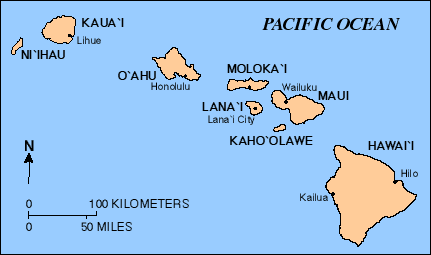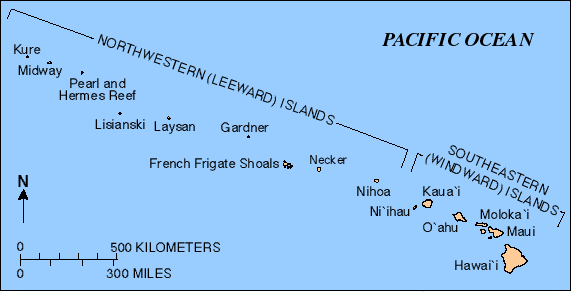
|
|
Hawaiian Volcanoes
The Hawaiian Islands are at the southeastern end of a chain of volcanoes that began to form more than 70 million years ago. Many of these volcanoes formed islands that have subsided and eroded beneath sea level, and some of the old volcanoes probably never reached sea level. Each Hawaiian island is made of one or more volcanoes, which first erupted on the sea floor and only emerged above the ocean's surface after countless eruptions.
The largest and most southeastern island of the chain, Hawai`i, consists of five volcanoes. Kilauea, Mauna Loa, and Hualalai have erupted in the past 200 years. Lo`ihi, the youngest volcano of the Hawaiian Volcanic Chain, is still about 1,000 meters beneath the ocean's surface. East Maui Volcano, commonly known as Haleakala, on the island of Maui, is the only other Hawaiian volcano to have erupted since the late 1700's.
Origin of the Hawaiian Island Volcanic Chain
An overview of "hot spots" and thermal plumes in the Earth's mantle is provided in this online USGS booklet about Plate Tectonics.

|
|
Map of the southeastern or "windward" Hawaiian Islands. The islands owe their existence to a "hot spot" in the Earth's mantle that has changed location only slightly over the past 70 million years. This hot spot is located beneath the southeastern part of Hawai`i.
Countless eruptions of lava fed by the hot spot built volcanoes that eventually grew above sea level to form islands. But the volcanoes didn't continue to erupt, because the seafloor on which they were built was continually moving northwestward across the hot spot at a rate of 7-9 cm per year. Eventually each volcano was torn away from the hot spot and carried northwestward, just as a conveyor belt moves material from one location to another. Such is the fate for the active volcanoes on the Big Island, though they will be replaced by new volcanoes, of which Lo`ihi is the first born. |
Maui
| West Maui Volcano
| East Maui Volcano (Haleakala) |
Kaho`olawe
Lana`i
Moloka`i
| West Moloka`i Volcano | East Moloka`i Volcano |
O`ahu
| Koolau Volcano | Waianae Volcano |
Kaua`i
Ni`ihau

|
|
Map of the Hawaiian Islands, a chain of volcanoes that stretches about 2,700 km in a northwesterly direction from the Island of Hawai`i. The age of the volcanoes that form the islands increases progressively from Hawai`i, where the volcanoes are still active, to the northwest end, where the volcanoes are about 30 million years old. The chain of volcanoes continues as seamounts for another 3,000 km; the chain bends sharply to the northward about 700 km beyond this map and becomes the Emperor Seamounts.
|
Contact: hvowebmaster@usgs.gov
Updated: 18 June, 2001 (pnf)

